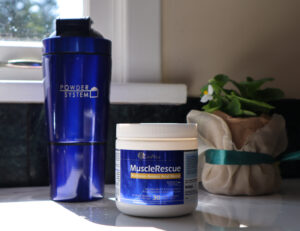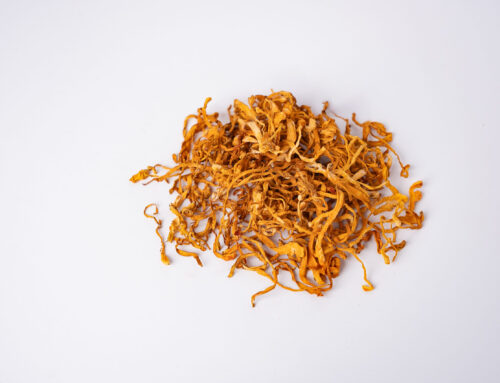Regular exercise is one of the best ways to improve health and increase longevity. The benefits of physical activity are vast and include cardiovascular health, bone and muscle strength, improved mood, and even reducing the risk of disease.
Healthy muscles are your best allies when it comes to exercise. Balancing exercise, nutrition and rest is the key to building and maintaining muscle health. Did you know that we have more than 600 muscles in our bodies? They’re the body’s movers and shakers, the engines powering our every move. Think of them as elastic bands that contract and relax, allowing us to walk, run, lift, and even blink. They’re made up of fibres that can shrink and lengthen, creating the force needed to pull bones and joints, giving us the ability to move. And in order to keep us moving, our muscles need a few key nutrients. Let’s dive in.
The importance of exercise and the different forms it takes
There are many different ways to get our bodies moving. These activities fall under two main types of exercise – aerobic and anaerobic.
Aerobic exercise, often called “cardio”, relies mainly on the body’s aerobic, or oxygen, system and uses a higher proportion of the slow-twitch muscle fibres, which are more resistant to fatigue. Aerobic exercise is usually rhythmic and lasts for an extended period of time, using large muscle groups such as our glutes, hamstrings, and core. Examples include running, swimming, skiing, and cycling.
Anaerobic exercise on the other hand, is an activity that breaks down glucose for energy without using oxygen. It typically involves short, fast, high-intensity activities, using fast-twitch muscle fibres. During anaerobic exercise, our muscles contract intensely at a level nearer to their maximum strength, which is why it is often preferred by individuals looking to improve their strength, speed, and power. Examples include weightlifting, sprinting and jumping rope.
During a workout our muscles require more fuel to keep going. To meet this demand, your heart pumps faster, pushing oxygen-rich blood to these hard working muscles. Simultaneously, our breathing quickens to bring in more oxygen and expel carbon dioxide, ensuring the body maintains a steady supply of these essentials while efficiently getting rid of waste.
This coordinated effort by our circulatory and respiratory systems not only sustains energy levels during workouts but also emphasizes the vital role of exercise in conditioning our body’s systems. Regular exercise helps train these systems, making them more efficient and enhancing overall health and fitness, allowing us to perform better and maintain a balanced, healthy lifestyle.
How are our muscles involved in exercise?
When we exercise, our muscles contract and relax, generating force, movement, and energy. Our bodies are composed of different types of muscles, each with their own unique roles. Let’s take a closer look at how they work.
Skeletal muscles
Connected to bones by resilient tissue bands called tendons, these muscles play a pivotal role in movement. When skeletal muscles contract, they tug on the tendons, consequently moving the bones. Ligaments, similar to tendons, link bones together, fortifying the structural framework of our skeleton. The majority of noticeable body actions, like running, walking, speaking, and eye movement take place due to the contraction of skeletal muscles.
Fun fact: Skeletal muscles help maintain the body’s temperature as almost 85% of heat comes from muscle contraction.
Smooth muscles
Also referred to as involuntary muscles, smooth muscles operate without conscious control. Found within the digestive and urinary system, they facilitate the movement of food and aid in expelling waste from the body. They are also present in our blood vessels, regulating blood pressure and oxygen supply to tissues. The heart is also considered an involuntary muscle, with the primary function of pumping blood throughout the body. Additionally, these muscles assist in maintaining the focus of your eyes without requiring active thought.
Key nutrients for muscle growth and repair
In order to fuel and develop our muscles, we must ensure they get the nutrients they need.
Carbohydrates
Simply put, carbs give you energy. They restore glycogen, a form of stored glucose in muscles, necessary for sustained energy during exercise. They provide the energy we need to convert protein into muscle mass. The more carbs we eat increases the glycogen stored in our muscles, resulting in fuller and more robust muscles. This not only enhances muscle endurance but also accelerates the pace of muscle growth. Opt for complex carbohydrates found in whole grains, fruits, vegetables, and legumes to provide sustained energy levels essential for muscle-building activities.
Magnesium
Muscle contraction is the classic example of how magnesium and calcium balance each other in the body. Insufficient magnesium causes calcium to stay in muscle and nerve cells longer, causing over-excitation. This can lead to cramps, spasms, and other muscle related issues. Muscles need magnesium in order to relax after contracting.
Studies also indicate that maintaining optimal levels of magnesium can actually benefit performance during exercise. This often translates to increased strength and power, along with enhancements in abilities like extension, flexion, rotation, and even jumping.
Protein and amino acids
Every cell in your body contains protein and amino acids are the building blocks of protein. Out of the 20 amino acids, 9 are deemed essential, while 11 are non-essential. Essential amino acids (EAA’s) are those that the body cannot produce on its own and must be acquired through diet or supplements. These amino acids not only contribute to building proteins, including muscle protein, but also serve as a vital energy source for various bodily functions, notably supporting muscle function. Non-essential amino acids on the other hand, are produced by the body. They actively support enzymatic activity, cellular repair, and the synthesis of various molecules necessary for proper organ function.
L-arginine plays a key role in muscle growth by supporting the synthesis of proteins, as well as improving blood flow. As muscles expand, L-arginine signals muscle cells to release growth hormone, assisting in fat metabolism. This dynamic process contributes to achieving toned, lean muscle mass. By reducing fat stores and promoting muscle growth, L-arginine enhances fitness, ultimately boosting strength. 
As essential amino acids are not produced by the body, and must be obtained through diet, incorporating a quality supplement is a great way to ensure your body gets the protein it needs to support muscle health.
MuscleRescue stands out from the crowd for its powerhouse ingredient – Reginator®. This proprietary blend boasts the most efficient ratio of essential amino acids (EAAs) required for protein synthesis and muscle regeneration. Unlike other supplements, MuscleRescue harnesses the precise combination of all nine EAAs plus L-arginine, essential for building and repairing muscle tissue.
How does MuscleRescue work?
Complete proteins containing all nine EAAs are vital for the body to construct and repair muscles. MuscleRescue takes this process to the next level, offering a scientifically proven precision blend.
Research indicates that just one scoop of MuscleRescue can outperform whey protein in promoting protein synthesis, showcasing its efficiency in muscle health. This optimal combination of amino acids not only aids in muscle protein synthesis but also plays a crucial role in preserving muscle function and strength. For someone who trains regularly, amino acids are important for facilitating recovery, building new muscle and supporting energy levels.
Did we mention that this formula is astronaut approved? MuscleRescue’s prowess wasn’t just observed in labs; it aced the test in zero-gravity environments, even impressing astronauts during deep space missions, highlighting its potential to combat muscle challenges in challenging environments. Talk about out-of-this-world effectiveness!
Should you be using MuscleRescue?
MuscleRescue is your go-to solution, whether you’re a seasoned gym enthusiast, a long-distance runner, or someone looking to maintain muscle strength during periods of reduced activity. It caters to a wide audience eager to boost their regular movement routines and take their fitness game to new heights.
And runners, this one’s for you too! For those pounding the pavement, MuscleRescue is a game-changer. The optimized EAA formula ensures that your muscles receive the essential nutrients they need to endure long-distance runs and recover efficiently. It’s not just about building muscle; it’s about sustaining endurance and promoting overall muscle function – a key factor for avid runners.
Taking care of your muscles tastes good too! MuscleRescue comes in two delightful flavours: Pineapple Punch and Fruit Punch.
We literally can’t make a move without the support of our muscles. That’s why it’s important that we give them the fuel they need, so that we can confidently power through our workouts and daily activities.







Leave A Comment